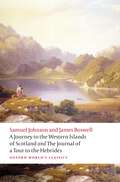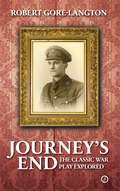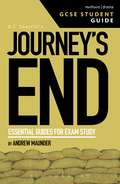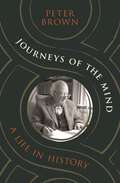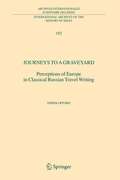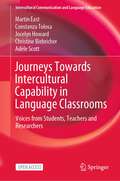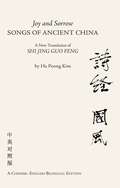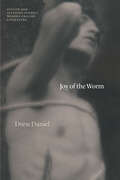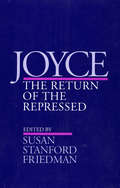- Table View
- List View
A Journey to the Western Islands of Scotland and the Journal of a Tour to the Hebrides (Oxford World's Classics)
by Samuel Johnson James BoswellIn 1773, James Boswell made a long-planned journey across the Scottish Highlands with his English friend Samuel Johnson; the two spent more than a hundred days together. Their tour of the Hebrides resulted in two books, A Journey to the Western Islands of Scotland (1775), a kind of locodescriptive ethnography and Johnson's most important work between his Shakespeare edition and his Lives of the Poets. The other, Boswell's Journal of a Tour to the Hebrides with Samuel Johnson (1785), a travel narrative experimenting with biography, the first application of the techniques he would use in his Life of Samuel Johnson (1791). These two works form a natural pair and, owing that they cover much of the same material, are often read together, focusing on the Scottish highlands. The text presents a lightly-edited version of both works, preserving the original orthography and corrected typographical errors to fit modern grammar standards. The introduction and notes provide clear and concise explanations on Johnson and Boswell's respective careers, their friendship and grand biographical projects. It also examines the Scottish Enlightenment, the status of England and Scotland during the Reformation through to the Union of the Crowns, and the Jacobite
Journey's End: The Classic War Play Explored (Oberon Modern Plays)
by Robert Gore-LangtonR C Sherriff’s Journey’s End is a syllabus text and the most famous play about World War One. First staged in 1928, this book tells the story of what went into the making of this extraordinary and powerful trench drama. It outlines Sherriff’s career from humble insurance clerk to infantry officer and his unforgettable 10 months on the western front before he was invalided home, lucky to be alive. Sherriff poured into his first professional play his personal experience of living in a front-line dug-out. Using his diary and letters home, the book charts his emotional life under fire and relates it directly to the play, its events and its characters. It also tells the story of Journey’s End’s incredible box office success across the world, a triumph which made its shy young author famous overnight.Taking in the history of the show right up to the most recent productions, Journey’s End: The Classic War Play Explored is a meditation on Journey’s End’s achievement as a war document, its fascination for audiences when it was first staged and its continuing grip on theatregoers and students today.
Journey's End GCSE Student Guide (GCSE Student Guides)
by Andrew MaunderWritten specifically for GCSE students by academics in the field, the Methuen Drama GCSE Guides conveniently gather indispensable resources and tips for successful understanding and writing all in one place, preparing students to approach their exams with confidence.Key features include a critical commentary of the play with extensive, clearly labelled analyses on themes, characters and context. They take studying drama even further with sections on dramatic technique, critical reception, related works, fascinating behind-the-scenes interviews with playwrights, directors or actors, and a helpful glossary of dramatic terms.Unmatched as a theatrical response to the First World War, R. C. Sherriff's Journey's End focuses on the experience of soldiers and the conditions in which they fought and died through a socially diverse regiment of English soldiers hiding in trenches in France.Carefully following the requirements of GCSE English Literature assessment objectives, these studies include expert advice on how to write about modern drama. With featured activities for group study and independent work, they are versatile and valuable to students and teachers alike.
Journey's End GCSE Student Guide (GCSE Student Guides)
by Andrew MaunderWritten specifically for GCSE students by academics in the field, the Methuen Drama GCSE Guides conveniently gather indispensable resources and tips for successful understanding and writing all in one place, preparing students to approach their exams with confidence.Key features include a critical commentary of the play with extensive, clearly labelled analyses on themes, characters and context. They take studying drama even further with sections on dramatic technique, critical reception, related works, fascinating behind-the-scenes interviews with playwrights, directors or actors, and a helpful glossary of dramatic terms.Unmatched as a theatrical response to the First World War, R. C. Sherriff's Journey's End focuses on the experience of soldiers and the conditions in which they fought and died through a socially diverse regiment of English soldiers hiding in trenches in France.Carefully following the requirements of GCSE English Literature assessment objectives, these studies include expert advice on how to write about modern drama. With featured activities for group study and independent work, they are versatile and valuable to students and teachers alike.
Journeys Exposed: Women’s Writing, Photography, and Mobility
by Giorgia AlùJourneys Exposed: Women's Writing, Photography, and Mobility examines contemporary literature written by women that are all in different ways related to Italy. It argues that photography provides women with a means to expose aspects of their nomadic self and of the others’ mobile lives within and beyond the writing process. By resorting to the visual, women individualistically respond to forms of hegemonic power, fragmentation, displacement, loss and marginality, and make these experiences key to their creative production.
Journeys Exposed: Women’s Writing, Photography, and Mobility
by Giorgia AlùJourneys Exposed: Women's Writing, Photography, and Mobility examines contemporary literature written by women that are all in different ways related to Italy. It argues that photography provides women with a means to expose aspects of their nomadic self and of the others’ mobile lives within and beyond the writing process. By resorting to the visual, women individualistically respond to forms of hegemonic power, fragmentation, displacement, loss and marginality, and make these experiences key to their creative production.
Journeys of Remembrance: Representations of Travel and Memory in Post-war French and German Literature
by Kathryn Jones"The Second World War was a common experience of cultural and historical rupture for many European countries, but studies of this period and its after-images often remain locked in national frameworks. Jones' comparative study of national memory cultures argues for a more nuanced view of responses to shared issues of remembrance. Focusing on the 1960s and 1970s, two decades of great change and debate in French and German discourses of memory, it investigates literary representations of the Second World War, and in particular the Holocaust, from France and both Germanies. The study encompasses thirteen works representing a variety of genres and divergent perspectives, and authors include Jorge Semprun, Peter Weiss, Georges Perec and Bernward Vesper. Addressing the underlying theme of travel as a means of exploring the past, it contrasts the journeys made by deportees and post-war visitors to the camps with the use of the journey as a literary device."
Journeys of Remembrance: Representations of Travel and Memory in Post-war French and German Literature
by Kathryn Jones"The Second World War was a common experience of cultural and historical rupture for many European countries, but studies of this period and its after-images often remain locked in national frameworks. Jones' comparative study of national memory cultures argues for a more nuanced view of responses to shared issues of remembrance. Focusing on the 1960s and 1970s, two decades of great change and debate in French and German discourses of memory, it investigates literary representations of the Second World War, and in particular the Holocaust, from France and both Germanies. The study encompasses thirteen works representing a variety of genres and divergent perspectives, and authors include Jorge Semprun, Peter Weiss, Georges Perec and Bernward Vesper. Addressing the underlying theme of travel as a means of exploring the past, it contrasts the journeys made by deportees and post-war visitors to the camps with the use of the journey as a literary device."
Journeys of the Mind: A Life in History
by Peter BrownA beautifully written personal account of the discovery of late antiquity by one of the world’s most influential and distinguished historiansThe end of the ancient world was long regarded by historians as a time of decadence, decline, and fall. In his career-long engagement with this era, the widely acclaimed and pathbreaking historian Peter Brown has shown, however, that the “neglected half-millennium” now known as late antiquity was in fact crucial to the development of modern Europe and the Middle East. In Journeys of the Mind, Brown recounts his life and work, describing his efforts to recapture the spirit of an age. As he and other scholars opened up the history of the classical world in its last centuries to the wider world of Eurasia and northern Africa, they discovered previously overlooked areas of religious and cultural creativity as well as foundational institution-building. A respect for diversity and outreach to the non-European world, relatively recent concerns in other fields, have been a matter of course for decades among the leading scholars of late antiquity.Documenting both his own intellectual development and the emergence of a new and influential field of study, Brown describes his childhood and education in Ireland, his university and academic training in England, and his extensive travels, particularly in the eastern Mediterranean and the Middle East. He discusses fruitful interactions with the work of scholars and colleagues that include the British anthropologist Mary Douglas and the French theorist Michel Foucault, and offers fascinating snapshots of such far-flung places as colonial Sudan, midcentury Oxford, and prerevolutionary Iran. With Journeys of the Mind, Brown offers an essential account of the “grand endeavor” to reimagine a decisive historical moment.
Journeys to a Graveyard: Perceptions of Europe in Classical Russian Travel Writing (International Archives of the History of Ideas Archives internationales d'histoire des idées #192)
by Derek OffordJourneys to a Graveyard examines the descriptions provided by eight Russian writers of journeys made to western European countries between 1697 and 1880. The descriptions reveal the mentality and preoccupations of the Russian social and intellectual elites during this period. The travellers' perceptions of western European countries are treated here as an ambivalent response to a civilization with which Russia was belatedly coming into close contact as a result of the imperial ambition of the Russian state and the westernization of the Russian elites. The travellers perceived the most advanced European countries as superior to Russia in terms of material achievement and the maturity and refinement of their cultures, but they also promoted a view of Russia as in other respects superior to the western nations. Heavily influenced from the late eighteenth century by Romanticism and by the rise of nationalism in the west, they tended to depict European civilization as moribund. By this means they managed to define their own emergent nation in a contrastive way as having youth and promising futurity.
Journeys Towards Intercultural Capability in Language Classrooms: Voices from Students, Teachers and Researchers (Intercultural Communication and Language Education)
by Martin East Constanza Tolosa Jocelyn Howard Christine Biebricher Adèle ScottThis open access book presents an account of five teacher educators who, over a two-year period, undertook a research project with five teachers of languages other than English in pre-secondary schools in New Zealand. Their collaborative aim was to develop students’ intercultural capability in the context of learning a new language. The school participants were typical of many in New Zealand’s pre-secondary sector; the teachers had limited language-teaching experience and limited prior knowledge of how to develop the intercultural dimension in their language classrooms, and the students were largely at the beginning stages of learning a new language. The book discusses the findings obtained using a range of data collection methods, including classroom observations, reflective interviews with teachers, and focus groups with students. It documents instances of breakthrough and growth for teachers and students and reveals the problems and tensions. Lastly, it reflects on the lessons learned in the course of this project and speculates on the roles that teacher education needs to play if the goal of intercultural capability is to be better achieved in language classrooms, both in New Zealand and internationally. Of interest to a wide range of stakeholders in the area of education, the book allows readers to gain an understanding of the opportunities of working with teachers through an action–research model, alongside the challenges that this brings and ways in which intercultural capability may be strengthened.
Joy
by David O. RussellJOY is the story of a family across four generations centered on the girl who becomes the woman who founds a business dynasty and, in the process, recovers her childhood magic and finds her place in the world.Betrayal, treachery, the loss of innocence and the scars of love, pave the road in this intense emotional and human comedy about becoming a true boss of family and enterprise.In this world of unforgiving commerce, allies become adversaries, adversaries becomes allies, an estranged husband becomes a friend, as Joy's inner life and fierce imagination carry her through the storm she faces.Jennifer Lawrence stars, with Robert De Niro, Bradley Cooper, Edgar Ramirez, Isabella Rossellini, Diane Ladd and Virginia Madsen.Like his previous films, JOY demonstrates David O. Russell's ability to find the extraordinary in the ordinary.
Joy and Sorrow Songs of Ancient China: A New Translation of Shi Jing Guo Feng (A Chinese-English Bilingual Edition)
by Ha Poong KimThe Shi Jing is the oldest anthology of Chinese songs. It contains 305 songs of ancient China, composed in the 12th to 7th century BCE. The collection is divided into four parts. The present work is a translation of its first part, namely Guo Feng, which translates as "songs of states" within the Zhou kingdom (1122-255 BCE). The Guo Feng songs were mostly sung by the common people of the kingdom. In this respect, they are unlike the songs in the other three parts, which are generally dynastic songs of the Zhou court. The songs included in this translation predate Confucius, many by several centuries. Accordingly, through them one may hear the spontaneous voices of pre-Confucian China. The text of the Shi Jing has come down to us at the present time in familiar Chinese characters. But their usage is so ancient that for centuries even Chinese readers have had to rely on a few standard commentaries, which all gave Confucian, moralistic readings of the songs, even of those that are unmistakably simple love songs. Ha Poong Kim's translation has incorporated the results of some recent Japanese studies which question the traditional, Confucian approach to the text, thereby recovering the original meaning of many songs in the Guo Feng. It is hoped that this Chinese-English Bilingual Edition makes the voices of joys and sorrows of this ancient land audible to a modern readership, not only in the West but also in China as well.
The Joy Of English: 100 Illuminating Conversations about the English Language
by Jesse KarjalainenThis is a pencil-sharp book about English for anyone who ever needs to write. In an easy-to-read style, it offers accessible and constructive advice to help you improve your English skills. It targets common pitfalls and those troublesome areas of English usage that affect everyone, no matter what their level of competence. It exposes several language myths and is bursting with 1,500 examples of both right and wrong usage. The Joy of English cuts to the heart of what readers want: help with their English. Its 100 short chapters provide answers to the questions that we are too afraid to ask - amateurs and professionals alike. Questions such as: Who versus whom? Less versus fewer? As versus because? In contrast to versus by contrast? Further versus farther? Learned versus learnt? Imply versus infer? Practice versus practise? Provided versus providing? While versus whilst? We live in the information age. Never in history has the need to communicate been so great. Everyone can improve their language skills. The Joy of English puts you on the path to new levels of competence and confidence.
Joy of the Worm: Suicide and Pleasure in Early Modern English Literature (Thinking Literature)
by Drew DanielConsulting an extensive archive of early modern literature, Joy of the Worm asserts that voluntary death in literature is not always a matter of tragedy. In this study, Drew Daniel identifies a surprisingly common aesthetic attitude that he calls “joy of the worm,” after Cleopatra’s embrace of the deadly asp in Shakespeare’s play—a pattern where voluntary death is imagined as an occasion for humor, mirth, ecstatic pleasure, even joy and celebration. Daniel draws both a historical and a conceptual distinction between “self-killing” and “suicide.” Standard intellectual histories of suicide in the early modern period have understandably emphasized attitudes of abhorrence, scorn, and severity toward voluntary death. Daniel reads an archive of literary scenes and passages, dating from 1534 to 1713, that complicate this picture. In their own distinct responses to the surrounding attitude of censure, writers including Shakespeare, Donne, Milton, and Addison imagine death not as sin or sickness, but instead as a heroic gift, sexual release, elemental return, amorous fusion, or political self-rescue. “Joy of the worm” emerges here as an aesthetic mode that shades into schadenfreude, sadistic cruelty, and deliberate “trolling,” but can also underwrite powerful feelings of belonging, devotion, and love.
Joy of the Worm: Suicide and Pleasure in Early Modern English Literature (Thinking Literature)
by Drew DanielConsulting an extensive archive of early modern literature, Joy of the Worm asserts that voluntary death in literature is not always a matter of tragedy. In this study, Drew Daniel identifies a surprisingly common aesthetic attitude that he calls “joy of the worm,” after Cleopatra’s embrace of the deadly asp in Shakespeare’s play—a pattern where voluntary death is imagined as an occasion for humor, mirth, ecstatic pleasure, even joy and celebration. Daniel draws both a historical and a conceptual distinction between “self-killing” and “suicide.” Standard intellectual histories of suicide in the early modern period have understandably emphasized attitudes of abhorrence, scorn, and severity toward voluntary death. Daniel reads an archive of literary scenes and passages, dating from 1534 to 1713, that complicate this picture. In their own distinct responses to the surrounding attitude of censure, writers including Shakespeare, Donne, Milton, and Addison imagine death not as sin or sickness, but instead as a heroic gift, sexual release, elemental return, amorous fusion, or political self-rescue. “Joy of the worm” emerges here as an aesthetic mode that shades into schadenfreude, sadistic cruelty, and deliberate “trolling,” but can also underwrite powerful feelings of belonging, devotion, and love.
The Joy-Ride and After
by A. L. BarkerThe Joy-Ride and After was A.L. Barker's third collection of shorter pieces, first published in 1963. It offers three novellas, linked by certain recurrent characters and by their variations on the themes of loneliness and insecurity. The first tells of what has led to a young garage-hand 'borrowing' his employer's car, and of the disastrous consequences that ensue. In the second, a betrayed wife loses her memory after an accident, and finds herself on a barge with an old reprobate. The third concerns the tribulations of a canteen manager who has an inscrutable boss and an extravagant wife. Whether they live in slum tenement or suburban semi-detached, these 'ordinary' people become alive and phenomenal to us through the force and sympathy of Barker's imagination.
Joyce: A Guide For The Perplexed (Guides for the Perplexed)
by Peter Mahon"In clear and simple prose, Mahon explains how to connect this little black box to the Joycean engine. Just pull some gears, it falls into place and works." -Jean-Michel Rabaté, Vartan Gregorian Professor in the Humanities at the University of Pennsylvania James Joyce's work has been regarded as some of the most obscure, challenging, and difficult writing ever committed to paper; it is also shamelessly funny and endlessly entertaining. Joyce: A Guide for the Perplexed celebrates the daring, humor and playfulness of Joyce's complex work while engaging with and elucidating the most demanding aspects of his writing. The book explores in detail the motifs and radical innovations of style and technique that characterize his major works-Dubliners, A Portrait of the Artist as a Young Man, Ulysses, and Finnegans Wake. By highlighting how Joyce's texts have been read by recent innovations in literary and cultural theory, Joyce: A Guide for the Perplexed offers the reader a Joyce that is contemporary, fresh, and relevant.
Joyce: The Return of the Repressed
Did James Joyce, that icon of modernity, spearhead the dismantling of the Cartesian subject? Or was he a supreme example of a modern man forever divided and never fully known to himself? This volume reads the dialogue of contradictory cultural voices in Joyce’s works—revolutionary and reactionary, critical and subject to critique, marginal and central. It includes ten essays that identify repressed elements in Joyce’s writings and examine how psychic and cultural repressions persistently surface in his texts. Contributors include Joseph A. Boone, Marilyn L. Brownstein, Jay Clayton, Laura Doyle, Susan Stanford Friedman, Christine Froula, Ellen Carol Jones, Alberto Moreirias, Richard Pearce, and Robert Spoo.
Joyce and Company (Continuum Literary Studies)
by David PierceJoyce and Company is a comparative study which encourages a way of thinking about Joyce not as an isolated figure but as someone who is best understood in the company of others whether from the past, the present or, indeed, the imagined future. Throughout, Pierce places Joyce and his time in dialogue with other figures or different historical periods or languages other than English. In this way, Joyce is seen anew in relation to other writers and contexts. The book is organised in four parts: Joyce and History, Joyce and Language, Joyce and the City, and Joyce and the Contemporary World. Pierce emphasises Joyce's position as both an Irish and a European writer and shows Joyce's continuing relevance to the twenty-first century, not least in his commitment to language, culture and a discourse on freedom.
Joyce and Company (Continuum Literary Studies)
by David PierceJoyce and Company is a comparative study which encourages a way of thinking about Joyce not as an isolated figure but as someone who is best understood in the company of others whether from the past, the present or, indeed, the imagined future. Throughout, Pierce places Joyce and his time in dialogue with other figures or different historical periods or languages other than English. In this way, Joyce is seen anew in relation to other writers and contexts. The book is organised in four parts: Joyce and History, Joyce and Language, Joyce and the City, and Joyce and the Contemporary World. Pierce emphasises Joyce's position as both an Irish and a European writer and shows Joyce's continuing relevance to the twenty-first century, not least in his commitment to language, culture and a discourse on freedom.
Joyce and Dante: The Shaping Imagination
by Mary Trackett ReynoldsMary Reynolds studies the rhetorical and linguistic maneuvers by which Joyce related his work to Dante's and shows how Joyce created in his own fiction a Dantean allegory of art. Dr. Reynolds argues that Joyce read Dante as a poet rather than as a Catholic; that Joyce was interested in Dante's criticism of society and, above all, in his great powers of innovation.Originally published in 1981.The Princeton Legacy Library uses the latest print-on-demand technology to again make available previously out-of-print books from the distinguished backlist of Princeton University Press. These editions preserve the original texts of these important books while presenting them in durable paperback and hardcover editions. The goal of the Princeton Legacy Library is to vastly increase access to the rich scholarly heritage found in the thousands of books published by Princeton University Press since its founding in 1905.
Joyce and Lacan: Reading, Writing and Psychoanalysis
by Daniel BristowWhat happens when the intellectual giant of twentieth-century literature, James Joyce, is made an object of consideration and cause of desire by the intellectual giant of modern psychoanalysis, Jacques Lacan? This is what Joyce and Lacan explores, in the three closely interrelated areas of reading, writing, and psychoanalysis, by delving into Joyce’s own relationship with psychoanalysis in his lifetime. The book concentrates primarily on his last text, Finnegans Wake, the notorious difficulty of which arises from its challenging the intellect itself, and our own processes of reading. As well as the centrality of the Wake, concepts of Joycean ontology, sanity, singularity, and sexuality are excavated from sustained analysis of his earliest writings onward. To be ‘post-Joycean’, as Lacan describes it, means then to be in the wake not only of Joyce, but also of Lacan’s interventions on the Irish writer made in the mid-70s. It was this encounter that gave rise to concepts that have gained currency in today’s psychoanalytic theory and practice, and importance in wider critical contexts. The notions of the sinthome, lalangue, and Lacan’s use of topology and knot theory are explored within, as well as new theories being launched. The book will be of interest to psychoanalysts, literary theorists, and students and teachers of literature, theory, or the works of Joyce and Lacan.
Joyce and Lacan: Reading, Writing and Psychoanalysis
by Daniel BristowWhat happens when the intellectual giant of twentieth-century literature, James Joyce, is made an object of consideration and cause of desire by the intellectual giant of modern psychoanalysis, Jacques Lacan? This is what Joyce and Lacan explores, in the three closely interrelated areas of reading, writing, and psychoanalysis, by delving into Joyce’s own relationship with psychoanalysis in his lifetime. The book concentrates primarily on his last text, Finnegans Wake, the notorious difficulty of which arises from its challenging the intellect itself, and our own processes of reading. As well as the centrality of the Wake, concepts of Joycean ontology, sanity, singularity, and sexuality are excavated from sustained analysis of his earliest writings onward. To be ‘post-Joycean’, as Lacan describes it, means then to be in the wake not only of Joyce, but also of Lacan’s interventions on the Irish writer made in the mid-70s. It was this encounter that gave rise to concepts that have gained currency in today’s psychoanalytic theory and practice, and importance in wider critical contexts. The notions of the sinthome, lalangue, and Lacan’s use of topology and knot theory are explored within, as well as new theories being launched. The book will be of interest to psychoanalysts, literary theorists, and students and teachers of literature, theory, or the works of Joyce and Lacan.
Joyce and the G-Men: J. Edgar Hoover’s Manipulation of Modernism
by C. CulletonSeveral years ago on a whim, Culleton requested James Joyce's FBI file. Hoover had Joyce under surveillance as a suspected Communist, and the chain of cross-references that Culleton followed from Joyce's file lead her to obscenity trials and, less obviously, to a plot to assassinate Irish labour leader James Larkin. Hoover devoted a great deal of energy to keeping watch on intellectuals and considered literature to be dangerous on a number of levels. Joyce and the G-Men explores how these linkages are indicative of the culture of the FBI under Hoover, and the resurgence of American anti-intellectualism.
